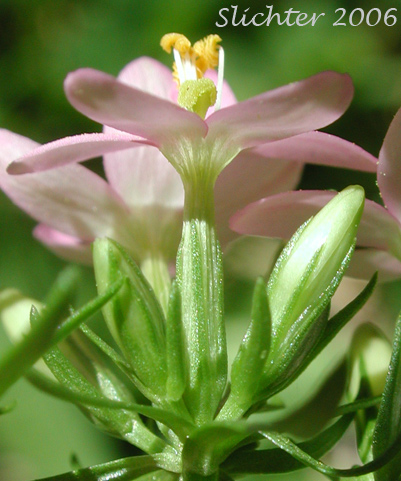 The photo at right shows a close-up sideview of the narrow calyx lobes and long corolla tube of common centaury. The corolla lobes flare from the corolla tube at approximately right angles to the tube.......July 28, 2006.
The photo at right shows a close-up sideview of the narrow calyx lobes and long corolla tube of common centaury. The corolla lobes flare from the corolla tube at approximately right angles to the tube.......July 28, 2006.
Common centaury is a small annual wildflower with one to several stems rising from 10-50 cm high. The stems may be simple or branched, and the leaves are opposite on the stems. The herbage is smooth (non-haired) and the basal leaves form a rosette of sessile, obovate to oblong-oblanceolate leaves from 1.5-4 cm long. The tips of the leaves are rounded and the blades are 3-5 nerved. The stem leaves become reduced in size upwards on the stem and the tips of the leaves become more pointed.
The pink flowers are numerous in crowded cymes. The calyx is 4-6 mm long with slender, acute-tipped lobes. The corolla is yellowish to salmon red with the tube twice the length of the calyx. The corolla lobes are 4-6 mm long and oblong-lanceolate in shape. The stamens extend slightly past the lobes. The anthers are 1.5-2 mm long and twisted.
Common centaury is found in moist soils in yards, waste areas, meadows, and on prairies.
Common centaury is a native of Europe which has been introduced (primarily west of the Cascade Mts.) from northwestern Washington south to California.
In the Columbia River Gorge, it may be found between the elevations of 0'-800' throughout the length of the Gorge.